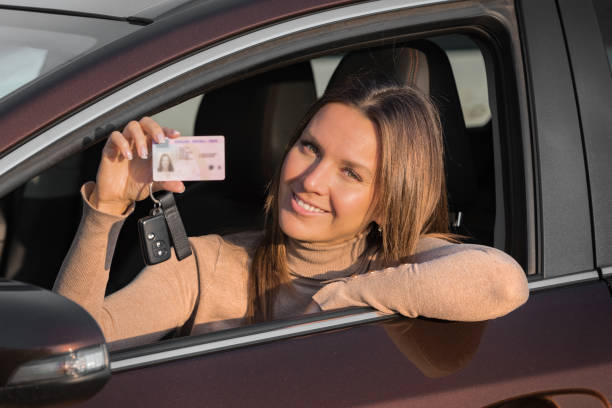Step-by-Step Process: How to Obtain a U.S. Driver's License
Obtaining a U.S. driver's license is an essential step for
many residents and newcomers to the country. Whether you're a new driver or
moving to a different state, here's a step-by-step guide to help you navigate
the process of getting your U.S. driver's license.
1. Determine Your Eligibility
Before you begin, make sure you meet the eligibility
requirements to obtain a U.S. driver's license. Requirements may vary by state,
but generally, you should be:
- A
resident of the state where you're applying.
- Of a
certain age (usually at least 16 years old for a standard driver's
license).
- Physically
and mentally fit to drive.
2. Gather Required Documents
Each state has specific documentation requirements, but
common documents you'll typically need include:
- Proof
of identity (e.g., passport, birth certificate).
- Proof
of residency (e.g., utility bill, lease agreement).
- Social
Security number or proof of ineligibility.
- Any
required immigration or legal status documents (for non-U.S. citizens).
Check with your state's Department of Motor Vehicles (DMV)
or equivalent agency for the exact list of required documents.
3. Complete Driver's Education (If Required)
Some states mandate completion of a driver's education
course before you can apply for a driver's license, especially for young or
first-time drivers. This course may include classroom instruction and
behind-the-wheel training.
4. Pass a Knowledge Test
You'll need to pass a written knowledge test, often based on
the state's driver's handbook or manual. The test typically covers traffic
laws, road signs, and safe driving practices. Study the handbook and take practice
tests to prepare.
5. Pass a Vision Test
Visit your local DMV or an approved vision testing center to
take a vision test. You must meet the state's minimum vision requirements to
obtain a driver's license.
6. Obtain a Learner's Permit
In many states, before getting a full driver's license, you
must first obtain a learner's permit. To do this, you'll need to:
- Visit
the DMV and complete an application.
- Pay
any required fees.
- Pass
the knowledge test and vision test.
- Provide
necessary documents.
- Pass a
written test on safe driving practices, typically taken at the DMV.
7. Practice Driving
With your learner's permit in hand, you can now practice
driving under the supervision of a licensed adult, often over 21 years of age.
The number of practice hours required varies by state.
8. Pass the Road Test
Once you've gained enough experience and confidence,
schedule a road test with your local DMV. The road test evaluates your
practical driving skills, including maneuvers, obeying traffic signs, and
handling various driving scenarios.
9. Get Your Full Driver's License
Upon successfully passing the road test and meeting all
other requirements, you'll be issued a full driver's license. Congratulations,
you're now a licensed driver!
10. Register Your Vehicle
If you plan to drive your own vehicle, you'll need to
register it with the state's DMV and obtain license plates and registration
tags.
11. Obtain Insurance
Before hitting the road, secure the required auto insurance
coverage to ensure you're legally protected while driving.
Remember that the specific steps and requirements may differ
from state to state. It's essential to check with your local DMV or equivalent
agency for the most accurate and up-to-date information. Additionally, some
states offer online services to make the process more convenient, so be sure to
explore these options as well.



![The Puppetman [2023]: Unraveling a Sinister Mystery](https://blogger.googleusercontent.com/img/b/R29vZ2xl/AVvXsEhtrHvbapON_8Cbeo8epkDxYKgrBe5mV3E1F-KxUnCZ1A9haipeOFisDGmgbDRhXIwTPbgQKbMLxudgSWqpUFNGVWG4OAzKKDOBLBDXqbkOJc5903ymI_GzsYknGLJEEhT72orUhOPH7aUrAnxQH5cdRVl1UyE-BO1i_mo9T53NG_0AQieZNYlMwLKQsBvZ/w640-h456/imgonline-com-ua-dexif369qMPIOZv15.jpg)
![Mortal Kombat Legends: Cage Match [2023]: A Fight for Survival](https://blogger.googleusercontent.com/img/b/R29vZ2xl/AVvXsEjV4dPAHnW1dgXrNXoHxbQAR9br0gEWvn6ASqRjBWh0h-z_qBRcBtxcBzC6TjM4lZuc7UVWxyIoc2fjSEhKmXbd8i1Cdq-I9QxTp0reNf9ykS3A94STGOstMy7tnpDZl6UDcKGAHznZoggBaAiLOaoGniwCZ3N3YsHSiz8N9FvbatlAWQux64IHH9HfF2bT/w640-h360/imgonline-com-ua-dexifS4605PUNXWJD.jpg)

![Monster Inside: America's Most Extreme Haunted House [2023]: Unmasking Horror](https://blogger.googleusercontent.com/img/b/R29vZ2xl/AVvXsEgDynbefQIT7F6TiCaej0OdXvOMgXgAOcbinn34jWjVsCfstntstwNkX_Yl_td2gQ9SiSN_923FsOhkrbHue4Zv1gZYT8LgRCSxu5wmBZ6NHu8sdL0UlxNplQbfBUVgJV2fs2N3uHLh6_eMCAJeROi61zvx1X-o6yPQyim4rKi7JNAtrs7e_sR1K3Lia99_/w640-h480/imgonline-com-ua-dexifq9nsAmAnLZ6X.jpg)